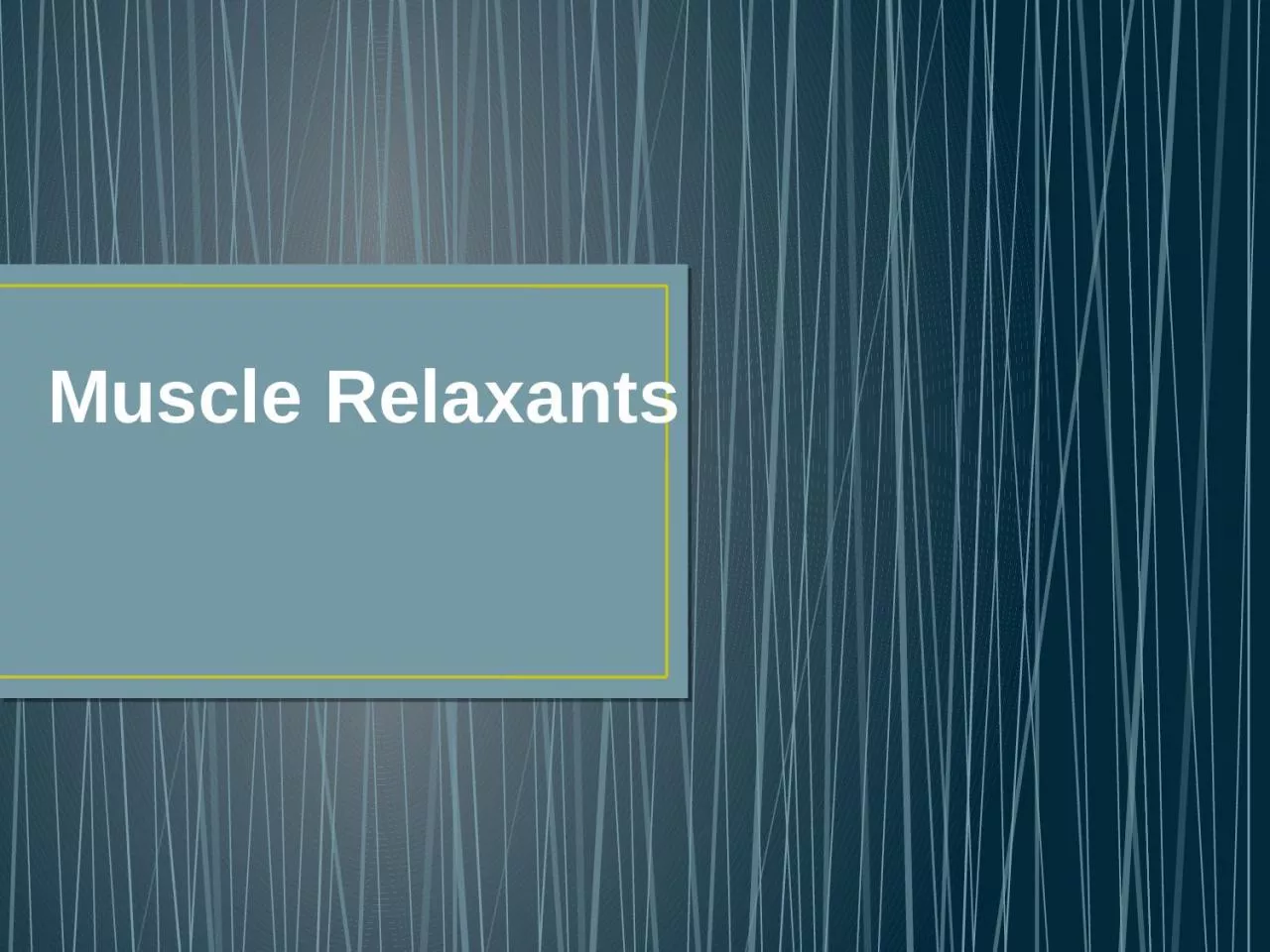

of Muscle Relaxants Centrally active Baclofen Benzodiazepines Tetrazepam Diazepam Clonazepam Thiocolchicoside Mephenoxalone Tizanidine Guaifenesin Orphenadrine Peripherally ID: 932745
Download Presentation The PPT/PDF document "Muscle R elaxants Overview" is the property of its rightful owner. Permission is granted to download and print the materials on this web site for personal, non-commercial use only, and to display it on your personal computer provided you do not modify the materials and that you retain all copyright notices contained in the materials. By downloading content from our website, you accept the terms of this agreement.
Slide1
Muscle
R
elaxants
Slide2Overview
of Muscle Relaxants
Centrally activeBaclofenBenzodiazepines:Tetrazepam DiazepamClonazepamThiocolchicosideMephenoxaloneTizanidineGuaifenesinOrphenadrine
Peripherally activePresynaptically active: botulinum toxinPostsynaptically active:Depolarizing blocking agents (suxamethonium)Non-depolarizing blocking agents (atracurium, vecuronium, pancuronium etc.)
Mechanism of action
Slide3Centrally
Active Agents
Attenuate transmission of motoric impulses in spinal cord and CNSDecrease muscle tone, do not influence intentional
contractions → weaker muscle relaxant activityAE: depression of CNS → sedation, somnolence, confusion…Acute and chronic painful spasms – p.o., parenterallySpastic rheumatism Damage of n. ischiadicus
(spasms of deep paravertebral
muscles
,
compressions
in
intervertebral
space
etc
.)
Spastic
disorders
associated
with
cerebral
palsy
,
multiple
sclerosis
,
injuries
of
brain
or
spine…
Slide4Centrally
Active AgentsMechanism
of action:Increase effects of inhibitory neurotransmitter γ-aminobutyric acid (GABA) in CNS and spine cordBaclofen
Attenuates the activation of motor neurons in the spine cordGABAB receptor agonistMultiple sclerosis, cerebral palsy, injuries of brain and spinal cord…
Slide5Centrally
Active AgentsBaclofen
Benzodiazepines:Tetrazepam DiazepamClonazepamThiocolchicosideMephenoxaloneTizanidineGuaifenesinOrphenadrinePsychiatric medication with 5 effects:AnxiolyticHypnotic
Muscle relaxantAnticonvulsantAmnesticLow doses have expectorant effect,Higher doses have muscle relaxant and anxiolytic effectMoA: Enhance of GABAergictransmission – GABAA receptors
Slide6Overview
of Muscle Relaxants
Centrally activeBaclofenBenzodiazepines:Tetrazepam DiazepamClonazepamThiocolchicosideMephenoxaloneTizanidineGuaifenesinOrphenadrine
Peripherally activePresynaptically active: botulinum toxinPostsynaptically active:Depolarizing blocking agents (suxamethonium)Non-depolarizing blocking agents (atracurium, vecuronium, pancuronium etc.)
Mechanism of action
Slide7Peripherally
Active Agents
1.) Presynaptically active agents Decrease ACh release Botulinum toxin 2.) Postsynaptically active agents
Act on nicotinic receptors (NM)Non-depolarizingDepolarizing
Slide8Non-
depolarizing agentsFirstly
described in 15th century by european explorers in S. AmericaUsed by natives as arrow poisons Tubocurarine – natural alkaloidCompetitive N
M receptors antagonistsAE: release of histamine (bronchoconstriction, hypotension, syncope – fainting)Progressive relaxation: eye muscles → muscles of mastication → neck and limbs →
trunk → diaphragmAdministered
parenterally
Effect
weakens
and
is
reversible
–
competition
of
receptors
Slide9Non-
depolarizing AgentsWith
long effect (1-2 h): tubocurarine, pancuronium, pipecuronium, vecuroniumWith short efect (10-30 min): alcuronium, atracuriumSurgery – muscle
relaxation in the operating field, or before mechanical ventilation (tracheal intubation)Ovedosing: antidote = acetylcholinesterase inhibitors (neostigmine, pyridostigmine…)
Slide10Depolarizing
AgentsNM
receptor agonists Open Na+ channels → cause long-term depolarization → resistancy to activation by ACh = depolarization blockadeRemain on the receptor for
a longer time, resistant to AChEFasciculation (muscle twitches) → muscle relaxation (paralysis)AE: cardiac arrhythmias, hyperkalemia, increase of intraocular pressure (IOP) + malignant
hyperthermia !
Slide11Decamethonium
Suxamethonium (succinylcholine)
Short-term muscle relaxation (3-5 min) Mechanical ventilation (tracheal intubation)Orthopedic manipulations – repositiong of dislocated joint,
fracturesDepolarizing Agents
Slide12Malignant
HyperthermiaRare AE
of depolarizing MR and/or volatile general anestheticsMechanisms:Defect of RYR receptor – controls release of Ca
2+ from sarcoplasmic reticulumIncrease of Ca2+ in myocyte → uncontrolled increase of contractions, aerobic/anaerobic metabolismSymptoms: hyperthermia, cramps and rigidity, ↑ heart rate and breathing
, cyanosis, lactate acidosis
,
rhabdomyolysis
...
60 %
of
untreated
cases
are
lethal
(5 %
of
treated
)
Therapy
:
dantrolene
,
intensive
cooling
Slide13Dantrolene
Peripherally active muscle
relaxantBlocks the release of Ca2+ from sarcoplasmic reticulum by interaction with RYRDo not affect
smooth muscle and myocardiumMalignant hyperthermiaSpastic disorders associated with spinal cord injury, stroke, cerebral palsy and multiple sclerosisAdvantage: no CNS depression